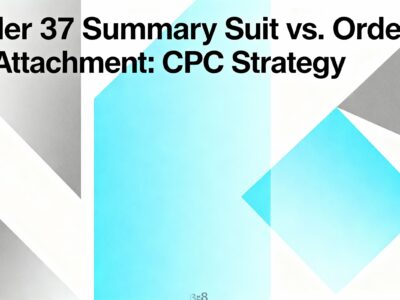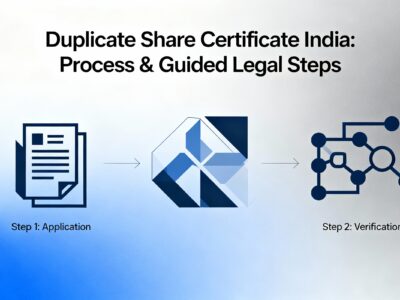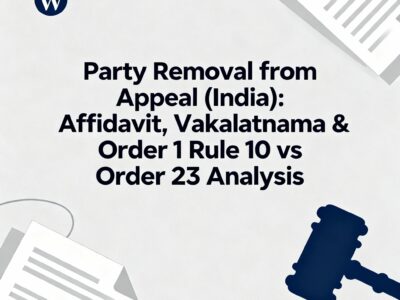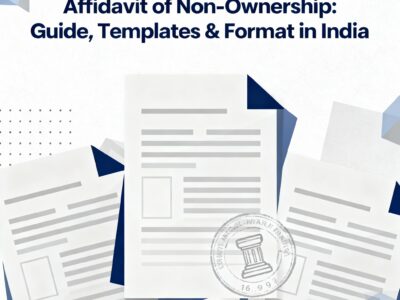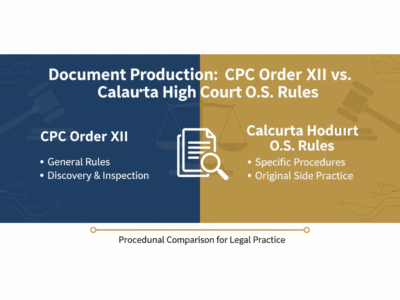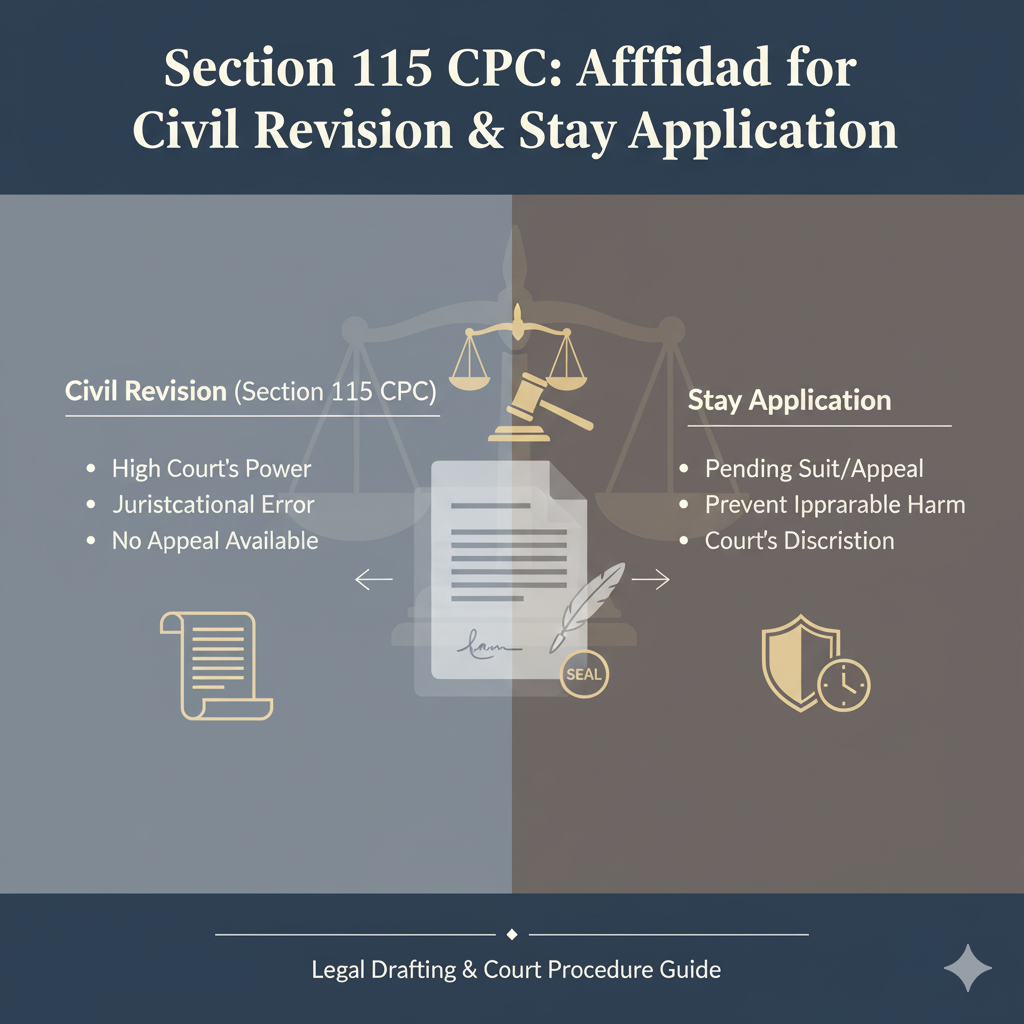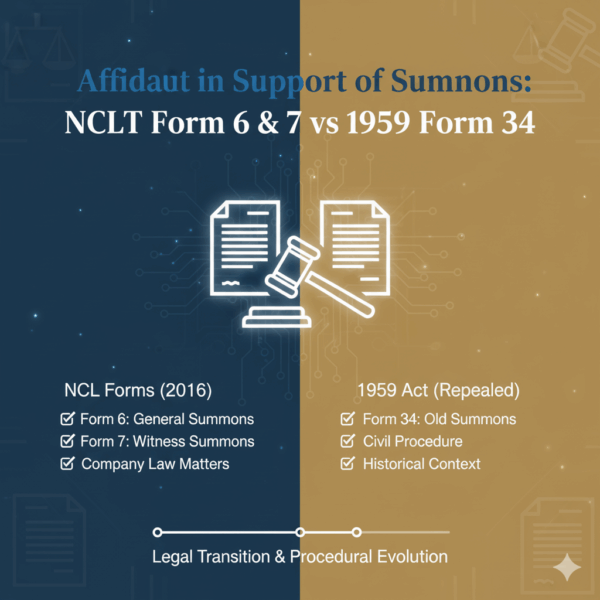Filing a maintenance petition under Section 125 CrPC involves a critical, and often confusing, two-affidavit process. This comprehensive 2025 guide simplifies everything. We’ll explain the difference between the procedural supporting affidavit and the mandatory Rajnesh v. Neha Affidavit of Disclosure, providing you with free templates for both. Read on to understand the complete process, from filing for interim maintenance to enforcing the final order and navigating common legal defences.
A Comprehensive Guide: Affidavits for Maintenance Under Section 125 CrPC
Understanding Section 125 CrPC: A Provision for Social Support
Section 125 of the Code of Criminal Procedure, 1973 (CrPC) is a foundational social justice provision in India. Its main objective is not to punish an individual but to provide a quick, summary remedy to prevent destitution. The Supreme Court of India has affirmed that the provision's purpose is to prevent "vagrancy and destitution."
This legal tool is designed to protect vulnerable members of society by empowering magistrates to order maintenance for wives, children, and parents who are unable to support themselves. The provisions are secular, applying to all persons regardless of their religion.
A Civil Right in a Criminal Court: The Procedural Advantage
An important and often misunderstood aspect of Section 125 is its unique procedural placement. The right to maintenance is essentially a civil right. However, proceedings are held to be "civil in nature," and the Magistrate's jurisdiction is "not strictly a criminal jurisdiction."
Placing this civil right within the Code of Criminal Procedure was a strategic legislative choice. A person facing destitution cannot be expected to endure the lengthy and expensive process of a full civil suit. The CrPC provides the *machinery* for a "speedy remedy" and a "summary" procedure. This allows a Magistrate to deal with situations requiring urgent attention, cutting through procedural delays to provide immediate financial relief.
Who Can Claim Maintenance?
Section 125(1) clearly defines the persons entitled to claim maintenance from an individual "having sufficient means" who "neglects or refuses" to maintain them.
The Wife
Includes a legally wedded wife, or a woman who has been divorced and has not remarried.
The Child
Minor children (legitimate or illegitimate) and adult children with physical or mental abnormalities.
The Parents
A father or mother who is unable to maintain himself or herself. This obligation extends to daughters as well.
Immediate Relief: The Role of Interim Maintenance
The legal process can be lengthy. Recognizing that a destitute applicant cannot wait months or years for a final judgment, the law provides a solution: **Interim Maintenance**. This is authorized by the first proviso to Section 125(1).
Interim maintenance is a temporary order by the court, directing the respondent to pay a monthly sum to the applicant *while the case is still pending*. The goal is to provide immediate financial support for basic survival.
How the Disclosure Affidavit Powers Interim Claims
This is where the *Rajnesh v. Neha* Affidavit of Disclosure becomes most powerful. Before this mandate, courts had to rely on guesswork to set an interim amount. Now, the court makes a *prima facie* (at first glance) assessment based on the two competing affidavits.
If the applicant's affidavit shows clear needs (rent, school fees) and the respondent's affidavit (or lack thereof) suggests sufficient income, the court can grant a reasonable interim amount. The Supreme Court, in *Rajnesh v. Neha*, directed that the interim maintenance application should be decided within 4 to 6 months.
Key Takeaway: Date of Grant
The Supreme Court has established a consistent practice: maintenance (both interim and final) should be awarded from the **date of filing the application**, not the date of the order. This prevents the respondent from benefiting by deliberately delaying the court proceedings.
The Modern Maintenance Claim: Why One Affidavit is No Longer Enough
A significant point of procedural confusion is the number of affidavits required. The process, in fact, mandates two distinct affidavits:
1. The Supporting Affidavit (Traditional)
This is a brief, procedural document. Its *sole purpose* is to serve as a sworn declaration by the petitioner that the factual statements made in the main petition are true to their knowledge.
2. The Affidavit of Disclosure (Mandatory)
This is a comprehensive, mandatory, and *substantive* document. It is the primary *evidence* upon which the court will determine the financial capacity of both parties and the amount of maintenance.
The Rajnesh v. Neha Judgment: A Mandate for Transparency
The mandatory nature of the second affidavit stems from the landmark Supreme Court judgment in *Rajnesh v. Neha* (2021). The Court observed a systemic problem: parties were submitting "scanty material," wives tended to exaggerate needs, and husbands tended to conceal income. This forced Family Courts to engage in "guess work" to fix maintenance.
To fix this, the Supreme Court mandated a "uniform format of Affidavit of Disclosure of Assets and Liabilities" to be filed by *both* parties in *all* maintenance proceedings across India, including cases under Section 125 CrPC.
Comparison: The Two Affidavits
The distinction between these two documents is summarized below.
| Feature | Affidavit 1: Supporting Affidavit | Affidavit 2: Affidavit of Disclosure |
|---|---|---|
| Common Name | Supporting Affidavit; Verification Affidavit | Income Affidavit; *Rajnesh v. Neha* Affidavit |
| Legal Basis | Procedural requirement | Supreme Court Mandate: *Rajnesh v. Neha (2021)* |
| Purpose | To swear that the facts in the main petition are true. | To provide full, transparent disclosure of all assets, income, liabilities, and expenses. |
| Content | Brief (1-2 pages). A few numbered paragraphs. | Exhaustive (10-20+ pages). Detailed, multi-part form. |
| When to File | Filed *with* the main petition. | **Applicant:** Filed *with* the main petition. **Respondent:** Filed *with* the reply. |
| Legal Status | Procedural. | Mandatory. Substantive. Forms the evidentiary basis for the maintenance amount. |
Affidavit 1: The Traditional Supporting Affidavit (Template)
The traditional Supporting Affidavit remains a necessary procedural component. Its function is to verify the allegations and facts presented in the main petition. It is the formal oath-taking that binds the petitioner to their story.
IN THE COURT OF THE METROPOLITAN MAGISTRATE / FAMILY COURT,
CRIMINAL COMPLAINT NO. __________ OF 20__
IN THE MATTER OF:
1. [Name of Petitioner 1]
2. [Name of Petitioner 2]
(Address:.........................)
... PETITIONERS
VERSUS
[Name of Respondent]
(Address:.........................)
... RESPONDENT
AFFIDAVIT
I, [Name of Petitioner 1], wife of [Husband's Name], aged [Age] years, presently residing at [Full Address], do hereby solemnly declare and affirm as follows:
1. That I am Petitioner No. 1 in the accompanying petition and I am fully conversant with the facts and circumstances of the case. I am competent to swear to this affidavit.
2. That Petitioner No. 2, [Name], is my minor son/daughter and is under my care and custody.
3. That whatever I have stated in the accompanying petition under Section 125 of the Code of Criminal Procedure, 1973, has been read over and explained to me.
4. That I have understood the contents of the same, which are true and correct to my knowledge and information received. The same may kindly be read as a part of this affidavit to avoid repetition.
5. That the said petition has been drafted by my counsel under my instructions.
DEPONENT
VERIFICATION
Verified at [Place] on this the [Day] day of [Month], 20__, that the contents of the above affidavit are true and correct to the best of my knowledge, belief, and information and nothing material has been concealed therefrom.
DEPONENT
Solemnly affirmed and signed before me.
ADVOCATE / NOTARY / OATH COMMISSIONERAffidavit 2: The Mandatory *Rajnesh v. Neha* Disclosure Affidavit
This is the new procedural backbone of all maintenance claims. The *Rajnesh v. Neha* judgment created a non-negotiable procedure.
- Who Files: *Both parties*—the applicant and the non-applicant/respondent.
- When to File: The applicant files it *with* the petition. The respondent files it *with* their reply (within a maximum of four weeks).
- Consequences of Non-Compliance: If a respondent willfully fails to file, the court has the power to "strike off the defence of the respondent." This is a serious penalty, allowing the court to decide the case *ex-parte* based only on the applicant's affidavit.
Analysis of the Disclosure Affidavit's Key Parts
The Supreme Court's format is exhaustive. Here is what each part is designed to achieve:
- Part A: Personal Information: Establishes the "status" of the parties. Educational and professional qualifications are a direct proxy for *earning capacity*.
- Part C: Dependent Family Members: For the applicant, this substantiates the *total financial need*. For the respondent, it is used to *reduce* his "net disposable income" by showing his own obligations.
- Part E: Details of Children: A granular breakdown of *all* child-related expenses (school fees, tuitions, medical, activities). This ensures the child's quality of life is maintained.
- Part F: Details of Income: Full disclosure supported by ITRs for the last 3 years, salary slips, and bank statements.
- Part G: Details of Respondent's Income: This is an effective procedural tactic. The applicant states their "best knowledge" of the respondent's income. The burden then shifts to the respondent to *disprove* this allegation with his own documented evidence.
- Part H: Statement of Assets: Full disclosure of property, bank accounts, investments, vehicles, etc. This counters the common "low income" defense. The court assesses *capacity* to pay, not just declared income.
- Part I: Details of Liabilities: Details of all loans, mortgages, and EMIs. This is the respondent's primary tool for *reducing* their "net disposable income."
- Part J: Details of Expenditure: A complete monthly budget. This must be realistic and align with the "marital lifestyle" claim.
Note: The full, multi-page template for the *Rajnesh v. Neha* affidavit is a standard format (Enclosure I in the judgment) provided by the Supreme Court and must be obtained and filled out meticulously.
The Maintenance Claim Process (Post Rajnesh v. Neha)
The Anchor: Drafting the Main Maintenance Petition (Template)
The two affidavits do not exist in a vacuum; they support the main *Petition for Maintenance*. This petition is the anchor document that establishes the narrative, the facts of the case, and the legal grounds for the claim.
IN THE COURT OF THE METROPOLITAN MAGISTRATE / FAMILY COURT,
CRIMINAL COMPLAINT NO. __________ OF 20__
IN THE MATTER OF:
1. [Name of Petitioner 1] (Wife)
2. [Name of Petitioner 2] (Minor Son/Daughter)
(Address:.........................)
... PETITIONERS
VERSUS
[Name of Respondent] (Husband)
(Address:.........................)
... RESPONDENT
SUBJECT: PETITION UNDER SECTION 125 OF THE CODE OF CRIMINAL PROCEDURE, 1973, FOR GRANT OF MAINTENANCE.
MOST RESPECTFULLY SHOWETH:
1. That the Petitioner No. 1 is the legally wedded wife of the Respondent, and Petitioner No. 2 is their minor son/daughter, born out of this wedlock.
2. That the marriage between Petitioner No. 1 and the Respondent was solemnized on [Date] at [Place] as per [e.g., Hindu] rites and ceremonies.
3. [Briefly state the narrative of the relationship, birth of children, etc.]
4. [Briefly state the narrative of cruelty, disputes, and/or neglect. Provide specific instances that led to the separation.]
5. That on [Date], the Respondent compelled the Petitioner(s) to leave the matrimonial home. Since that day, the Petitioner(s) have been residing at [e.g., her parental home].
6. That the Petitioner(s) have been neglected by the Respondent, who has failed and refused to provide any maintenance for their livelihood, despite having sufficient means to do so.
7. That the Petitioner No. 1 is [e.g., a homemaker] and has no independent source of income and is wholly unable to maintain herself and the minor child, Petitioner No. 2.
8. That the Respondent, on the other hand, is a person of substantial means. He is employed as [Job Title] at [Company Name] and earns approximately Rs. [Amount] per month. [Add other known income/assets].
9. That the accompanying Affidavit of Disclosure of Assets and Liabilities (as per the guidelines in Rajnesh v. Neha) is filed with this petition, detailing the financial status of the Petitioner.
10. That this Hon'ble Court has the jurisdiction to try and adjudicate this petition.
PRAYER
It is, therefore, most respectfully prayed that this Hon'ble Court may be pleased to:
(a) Direct the Respondent to pay a monthly maintenance allowance of Rs. [Amount] to Petitioner No. 1 and Rs. [Amount] to Petitioner No. 2 from the date of filing of this application.
(b) Direct the Respondent to pay a sum of Rs. [Amount] towards the costs of this litigation.
(c) Pass any other order or relief(s) as this Hon'ble Court may deem fit.
PETITIONER(S)
Through
COUNSEL FOR THE PETITIONER(S)
Date:
Place:
(To be accompanied by Supporting Affidavit and Affidavit of Disclosure)
Strategic Insights: Making Your Claim Coherent
A successful maintenance claim rests on the perfect alignment of three documents: the Main Petition, the Supporting Affidavit, and the Affidavit of Disclosure. These documents must tell one consistent story.
- The Main Petition makes the *allegation* (e.g., "The Respondent earns Rs. 2,00,000 per month").
- The Supporting Affidavit *swears* that this allegation is "true and correct."
- The Affidavit of Disclosure *details* this allegation (e.g., "Rs. 1,50,000 from salary, Rs. 50,000 from rental income") and provides the *justification* for the claim (e.g., "Petitioner's total monthly expenses are Rs. 75,000").
Any inconsistency—such as claiming a high-status lifestyle in the petition while listing minimal expenses in the affidavit—will be used by opposing counsel to damage the petitioner's credibility.
Finally, the *Rajnesh v. Neha* affidavit becomes *evidence* only when supported by documents. A claim for "school fees" must be annexed with the *fee receipt*. A claim for "low income" is only credible if supported by bank statements and ITRs. The affidavit is the map; the annexed documents are the territory.
Enforcement of Maintenance: Section 125(3)
Receiving a maintenance order is only half the battle; ensuring timely payment is the other half. Section 125(3) provides the mechanism for *enforcing* the order if the respondent fails to pay "without sufficient cause."
If the respondent defaults, the applicant must file an execution petition. The Magistrate can then:
- Issue a Warrant: A warrant is issued to levy the amount due from the respondent's assets, similar to recovering a fine. This can involve attachment and sale of property (movable or immovable).
- Order Attachment of Salary: If the respondent is salaried, the court can order their employer to deduct the maintenance amount directly from their salary.
- Order Imprisonment: If the amount cannot be recovered, the Magistrate can sentence the respondent to imprisonment for a term which may extend to *one month* for each month's unpaid maintenance (or until payment is made, whichever is sooner).
Critical Limitation Period
A key proviso in Section 125(3) states that no warrant shall be issued for any amount due unless the application for execution is made within **one year** from the date on which that amount became due. This means an applicant must not let arrears pile up for more than a year; they must file for execution promptly.
The Enforcement Process Flow
Respondent Misses Payment
The maintenance order passed by the court is not complied with.
File Execution Petition
Applicant files a new petition in court (within 1 year of the due date).
Court Issues Warrant
Court orders recovery via distress warrant, salary attachment, etc.
Imprisonment (Last Resort)
If payment is still not made, the respondent faces imprisonment.
Common Defences Raised by the Respondent
The respondent (husband, father, or son) also has the right to contest the maintenance claim. Section 125(4) and 125(5) outline specific statutory defences.
| Common Defence | Legal Basis / Counter-Argument |
|---|---|
| "The wife is living in adultery." | Section 125(4): This is a complete bar to receiving maintenance. However, the burden of proof is very high and requires strict evidence, not mere allegations. |
| "She left without sufficient reason." | Section 125(4): If a wife refuses to live with her husband without any "sufficient reason," she is not entitled to maintenance. However, "sufficient reason" is interpreted broadly and includes domestic violence, cruelty, or the husband's extra-marital affair. |
| "We are living separately by mutual consent." | Section 125(4): This is also a bar to maintenance. This is often alleged by citing a "mutual consent" divorce petition or a settlement agreement. |
| "The wife is earning and can maintain herself." | Section 125(1): The law is for those "unable to maintain" themselves. However, courts now look at *adequacy*. A wife's small income may not be sufficient to maintain herself *and* the child at the standard of the marital home, making her eligible for *some* maintenance. |
| "I have no sufficient means." | This is the most common defence. The *Rajnesh v. Neha* affidavit directly counters this by forcing disclosure. An able-bodied man is presumed to have the *capacity* to earn, even if he claims to be unemployed. |
Quantum of Maintenance: How is the Amount Decided?
There is no fixed mathematical formula (like a percentage) for calculating maintenance in India. The court has wide discretion to award an amount that is "reasonable and fair." The court performs a balancing act, considering multiple factors.
Factors Weighed by the Court
Status & Marital Lifestyle
The applicant is entitled to the same standard of living she was accustomed to in her matrimonial home.
Needs of the Applicant
Realistic monthly expenses for rent, food, utilities, clothing, and medical care, as detailed in the Disclosure Affidavit.
Income & Capacity of Respondent
The court assesses not just the declared income, but the *earning capacity*. An educated, able-bodied person is expected to earn.
Liabilities of Both Parties
The respondent's EMIs, loans, and responsibility towards other dependents (like aged parents) are also considered.
While some High Court judgments have used 25% of the husband's net income as a "benchmark" or "just guide" (e.g., *Kalyan Dey Chowdhury v. Rita Dey Chowdhury*), this is *not* a binding rule. The *Rajnesh v. Neha* affidavit, with its detailed expense and asset lists, has largely replaced such benchmarks with a more holistic, evidence-based calculation.
Frequently Asked Questions (FAQ)
Yes. The "unable to maintain herself" clause is relative. If the wife's income is nominal or insufficient to support the standard of living she had in the marital home, she can still claim maintenance. The court will consider her income and the respondent's income to determine a "gap" or "top-up" amount.
The court assesses *earning capacity*, not just declared income. An able-bodied, educated man is presumed to be capable of earning. If he is hiding income, the applicant's lawyer can file an application under Section 91 CrPC to summon documents like his bank statements, ITRs, and salary details from his employer, which will expose the true financial picture. The *Rajnesh v. Neha* affidavit also forces him to state his assets on oath, which is difficult to hide.
For a Wife: Maintenance is payable until she remarries.
For a Minor Child: Maintenance is payable until the child attains the age of majority (18 years). For a female child, the father may be liable for her marriage expenses even after she turns 18, depending on personal law.
For an Adult Child: Maintenance continues indefinitely if the child (male or female) has a physical or mental abnormality and is unable to maintain themselves.
Yes. Section 127 of the CrPC allows for "Alteration in allowance." If there is a "change in the circumstances" of either party (e.g., respondent gets a major promotion, applicant gets a high-paying job, child has new educational expenses), either party can file a petition to have the maintenance amount increased or decreased.


